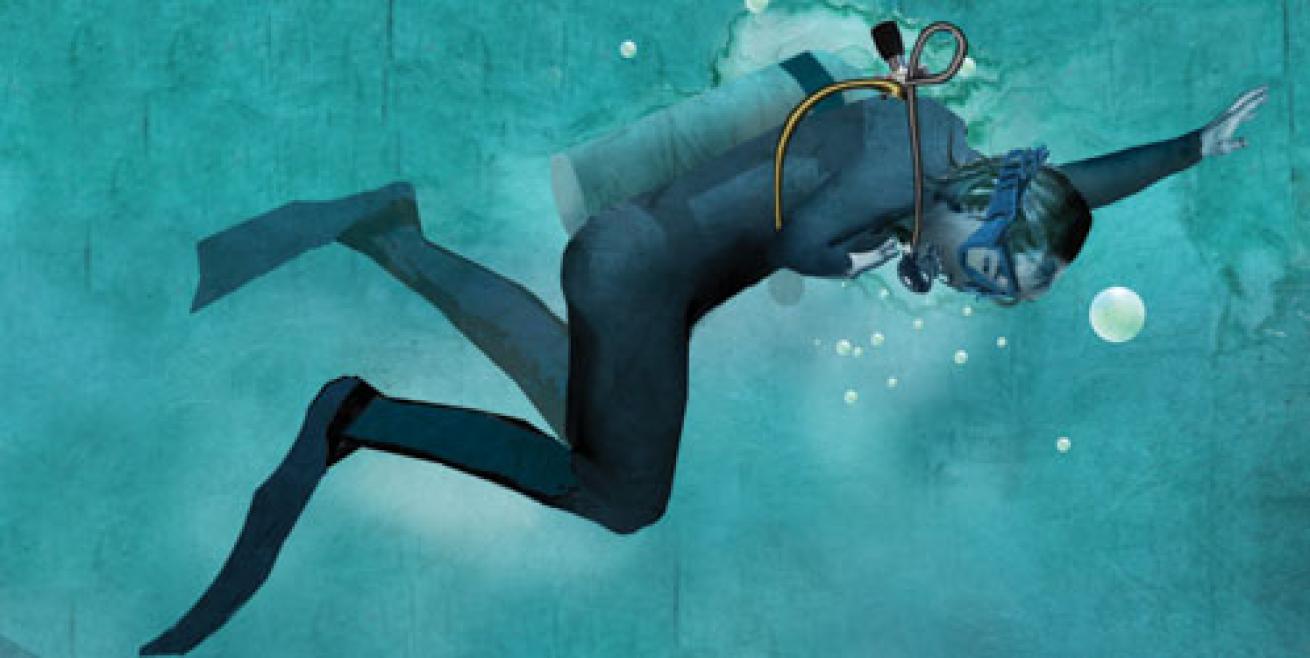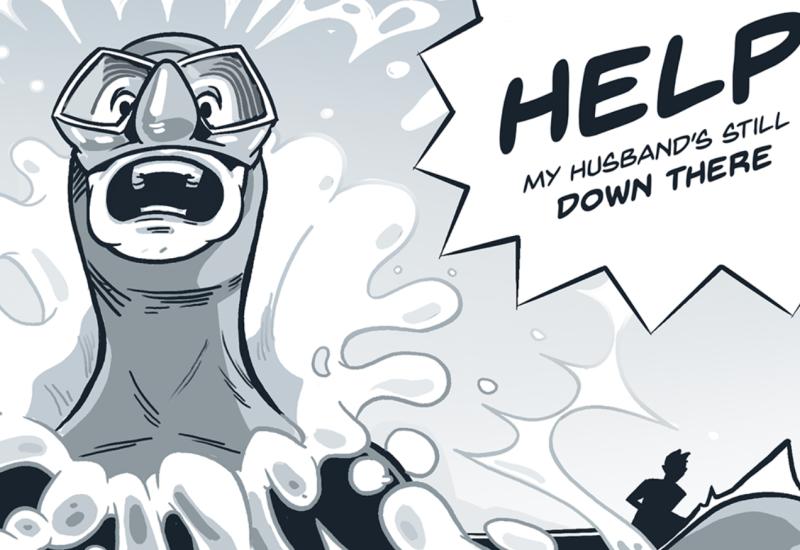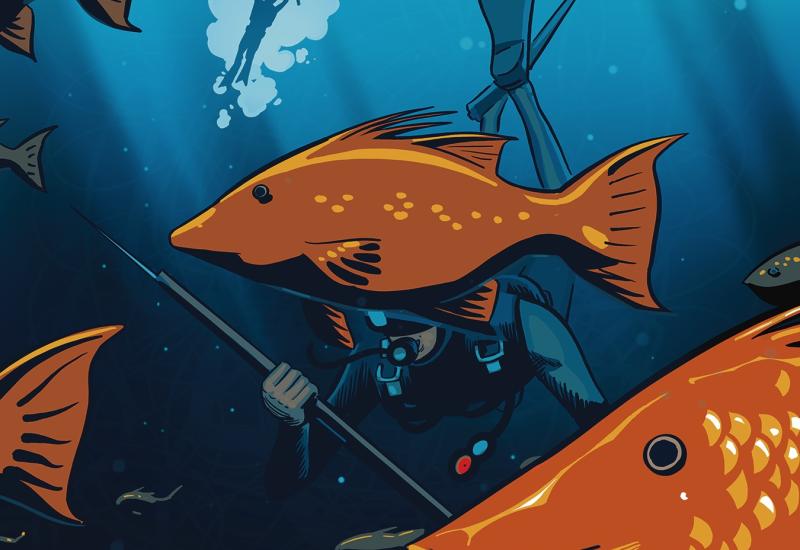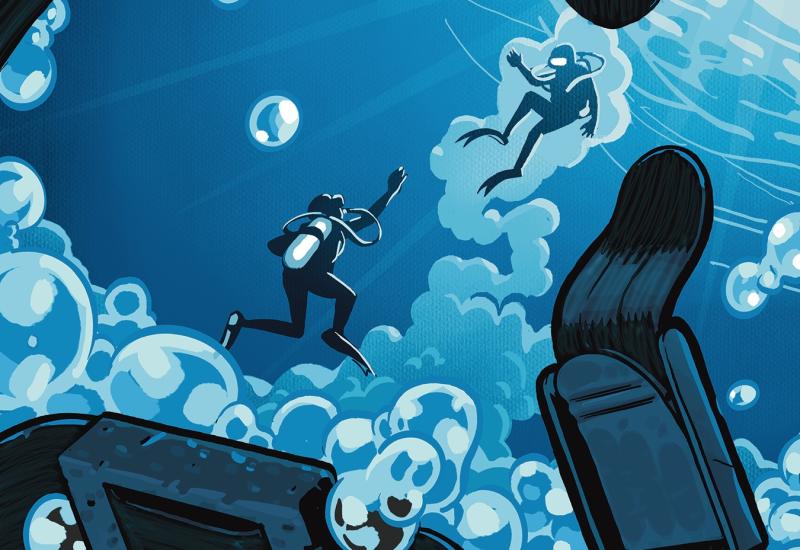Lessons for Life: Lying to Dive

Scuba Diving Safety: Lessons for Life
Lynn wasn’t feeling quite right before the dive, but she always felt better underwater, so she kept getting ready. She had worked so hard to return to diving that she wasn’t going to let anything stop her. The divemaster briefed the divers about the strong current on the bottom and told them to stay close to and behind the wreck so they wouldn’t have to fight it. As Lynn swam away from the anchor line, she could feel the current pushing against her. She kicked harder to compensate and get out of the flow, but she couldn’t seem to catch her breath. Then the pain started in her chest: It was a throbbing feeling, radiating down her left shoulder and burning behind her breastbone.
The Diver
Lynn had been a diver for many years. She learned to dive when she was in her 30s. Now, 25 years later and nearly 60, she was still at it. She wasn’t as active as she once was, both in the water and out of it, but she loved to go diving whenever she could. It was part of her life and her friends had all heard her say that she would “die” if she couldn’t dive any more. In the last couple of years, Lynn’s health took a turn for the worse, though. She didn’t smoke, and she exercised regularly and controlled her weight, but she developed a heart condition and had a heart attack. In women, heart disease is often referred to as the “silent killer” — most people think of heart attacks and heart disease as being a male problem, but it affects women as well. Heart disease is the No. 1 killer of women in the United States and is the leading cause of disability in women. Two-thirds of women who have a heart attack fail to make a full recovery.
The Dive
The dive boat anchored on a mooring ball, connected to a frequently dived shipwreck off the coast. It was about 100 feet to the sand, with the upper structure of the wreck at around 50 feet. The wreck was nearly 300 feet long, listing slightly to its port side. Conditions varied on the site and could change quickly. Most of the time, though, the current crossed the wreck from right to left (starboard to port), allowing divers to spend most of their time following the upper decks of the wreck shielded from the current by the wreck’s superstructure. Where the mooring ball was connected, Lynn and her dive buddy had to swim about 30 yards against the current to get down behind the wreck. From that point, they would be able to swim easily and then ride the current back to the anchor line when it was time to ascend. Visibility was average for the day, about 25 feet, and the sun was shining.
The Accident
Two years before, almost to the day, Lynn had a heart attack. This dive trip was her celebration of a return to diving. While she was excited about getting back in the water, she didn’t get clearance from her doctor to dive. When she signed the liability release form at the dive shop before the charter boat left the dock, she chose to lie on the form. She indicated that she had no medical conditions and was not taking any medications. Whether the unease and discomfort she felt before she began the dive came from being away from the water for more than two years, or whether it was the onset of a second heart attack, we’ll never know. As Lynn and her buddy moved away from the anchor line and fought the current to get behind the wreck, Lynn’s breathing became ragged. She couldn’t catch her breath and the throbbing feeling in her chest grew. Her buddy passed her as he made his way to the wreck and lost sight of her. She suddenly stopped kicking and began floating backward, pushed by the current. Her buddy made it to the wreck and turned to look for Lynn. She was already drifting out of sight.
Analysis
Fitness to dive is something you need to keep in mind daily for proper scuba diving safety. Even if you were once cleared to dive, you might not be truly fit on any given day. Lack of sleep, alcohol use, colds and flu or other issues often can keep us out of the water — or at least should. There are major medical issues, though, that most divers recognize as being contrary to diving. Years ago, the Recreational Scuba Training Council agreed on a set of medical issues that were called contraindications to diving. These are situations or conditions that, while present, should keep divers out of the water. The release form that every diver signs to begin training and usually to make dives on a charter boat is designed to remind divers of these issues, and signal to the diver that if he has one of these conditions, he will need a doctor’s clearance before making that dive. It forces divers to take responsibility for their actions. Because getting a clearance from a doctor is often time consuming, some divers choose to lie on this form and don’t admit to outstanding medical conditions. Many times, those divers dive with no problems, leading them to think that they are actually healthy — or healthy enough to make the dives they plan to make. Nothing could be further from the truth, and many of these divers are time bombs waiting to explode. Divers Alert Network reviews dive-fatality cases and publishes an annual accident report that is available for free to all divers. DAN’s report has found that the majority of all dive fatalities are caused by divers having heart attacks in the water. While these heart attacks could have happened anywhere, when they happen in the water they are almost certainly fatal. Even when everything goes right, the delay in getting the diver to the surface and onto the boat, out of the gear and getting CPR or an AED started is usually too much. Your chance of survival from cardiac arrest drops about 10 percent every minute you don’t receive treatment. After four minutes or so, brain death begins. After about 10 minutes in cardiac arrest, your chance of survival, even with an AED, is almost nonexistent. And that is only when things go right. More often, the diver will lose consciousness underwater. The regulator falls from her mouth and she drowns, long before rescuers can provide any care. In Lynn’s case, she should have consulted her doctor for further follow-up and medical clearance. This would have included her undergoing a stress test with her cardiologist that would have shown she had residual problems. There is nothing to keep a diver from returning to diving after a heart attack or cardiac surgery, as long as the diver meets the exercise requirements of the dive and gets the approval of her doctor.
Lessons for Life
• Don’t lie on your liability release. Medical conditions are nothing to ignore. An increased risk of a dive accident not only puts you at greater risk in the water, it also exposes your dive buddy and the dive crew to risk as well. If those divers have to perform a rescue, they are in danger caused by your medical condition.
• Seek medical clearance before diving. If you have a medical condition considered to be a contraindication to scuba diving (see www.wrstc.com/downloads/RSTCMedStatementGeneric.pdf for a list), you should consult a physician knowledgeable in diving medicine. Many physicians do not understand the unique nature of diving and the stresses placed on the body. Without a background or familiarity in diving medicine, physicians have given poor advice without meaning to do so.
• Be fit enough to do the diving you plan to do. General fitness is important for diving. Divers don’t need to be great swimmers, but a general level of fitness is important so you can respond to situations underwater. When you find yourself facing a strong, unexpected current or a long swim back to the boat, you shouldn’t be struggling to get where you want to be. _
Eric Douglas co-authored the book_ Scuba Diving Safety_, and has also written a series of dive adventure novels and short stories. Check out his website at www.booksbyeric.com._

IllustrationLessons for Life: Lying to Dive
Scuba Diving Safety: Lessons for Life
Lynn wasn’t feeling quite right before the dive, but she always felt better underwater, so she kept getting ready. She had worked so hard to return to diving that she wasn’t going to let anything stop her. The divemaster briefed the divers about the strong current on the bottom and told them to stay close to and behind the wreck so they wouldn’t have to fight it. As Lynn swam away from the anchor line, she could feel the current pushing against her. She kicked harder to compensate and get out of the flow, but she couldn’t seem to catch her breath. Then the pain started in her chest: It was a throbbing feeling, radiating down her left shoulder and burning behind her breastbone.
The Diver
Lynn had been a diver for many years. She learned to dive when she was in her 30s. Now, 25 years later and nearly 60, she was still at it. She wasn’t as active as she once was, both in the water and out of it, but she loved to go diving whenever she could. It was part of her life and her friends had all heard her say that she would “die” if she couldn’t dive any more. In the last couple of years, Lynn’s health took a turn for the worse, though. She didn’t smoke, and she exercised regularly and controlled her weight, but she developed a heart condition and had a heart attack. In women, heart disease is often referred to as the “silent killer” — most people think of heart attacks and heart disease as being a male problem, but it affects women as well. Heart disease is the No. 1 killer of women in the United States and is the leading cause of disability in women. Two-thirds of women who have a heart attack fail to make a full recovery.
The Dive
The dive boat anchored on a mooring ball, connected to a frequently dived shipwreck off the coast. It was about 100 feet to the sand, with the upper structure of the wreck at around 50 feet. The wreck was nearly 300 feet long, listing slightly to its port side. Conditions varied on the site and could change quickly. Most of the time, though, the current crossed the wreck from right to left (starboard to port), allowing divers to spend most of their time following the upper decks of the wreck shielded from the current by the wreck’s superstructure. Where the mooring ball was connected, Lynn and her dive buddy had to swim about 30 yards against the current to get down behind the wreck. From that point, they would be able to swim easily and then ride the current back to the anchor line when it was time to ascend. Visibility was average for the day, about 25 feet, and the sun was shining.
The Accident
Two years before, almost to the day, Lynn had a heart attack. This dive trip was her celebration of a return to diving. While she was excited about getting back in the water, she didn’t get clearance from her doctor to dive. When she signed the liability release form at the dive shop before the charter boat left the dock, she chose to lie on the form. She indicated that she had no medical conditions and was not taking any medications. Whether the unease and discomfort she felt before she began the dive came from being away from the water for more than two years, or whether it was the onset of a second heart attack, we’ll never know. As Lynn and her buddy moved away from the anchor line and fought the current to get behind the wreck, Lynn’s breathing became ragged. She couldn’t catch her breath and the throbbing feeling in her chest grew. Her buddy passed her as he made his way to the wreck and lost sight of her. She suddenly stopped kicking and began floating backward, pushed by the current. Her buddy made it to the wreck and turned to look for Lynn. She was already drifting out of sight.
Analysis
Fitness to dive is something you need to keep in mind daily for proper scuba diving safety. Even if you were once cleared to dive, you might not be truly fit on any given day. Lack of sleep, alcohol use, colds and flu or other issues often can keep us out of the water — or at least should. There are major medical issues, though, that most divers recognize as being contrary to diving. Years ago, the Recreational Scuba Training Council agreed on a set of medical issues that were called contraindications to diving. These are situations or conditions that, while present, should keep divers out of the water. The release form that every diver signs to begin training and usually to make dives on a charter boat is designed to remind divers of these issues, and signal to the diver that if he has one of these conditions, he will need a doctor’s clearance before making that dive. It forces divers to take responsibility for their actions. Because getting a clearance from a doctor is often time consuming, some divers choose to lie on this form and don’t admit to outstanding medical conditions. Many times, those divers dive with no problems, leading them to think that they are actually healthy — or healthy enough to make the dives they plan to make. Nothing could be further from the truth, and many of these divers are time bombs waiting to explode. Divers Alert Network reviews dive-fatality cases and publishes an annual accident report that is available for free to all divers. DAN’s report has found that the majority of all dive fatalities are caused by divers having heart attacks in the water. While these heart attacks could have happened anywhere, when they happen in the water they are almost certainly fatal. Even when everything goes right, the delay in getting the diver to the surface and onto the boat, out of the gear and getting CPR or an AED started is usually too much. Your chance of survival from cardiac arrest drops about 10 percent every minute you don’t receive treatment. After four minutes or so, brain death begins. After about 10 minutes in cardiac arrest, your chance of survival, even with an AED, is almost nonexistent. And that is only when things go right. More often, the diver will lose consciousness underwater. The regulator falls from her mouth and she drowns, long before rescuers can provide any care. In Lynn’s case, she should have consulted her doctor for further follow-up and medical clearance. This would have included her undergoing a stress test with her cardiologist that would have shown she had residual problems. There is nothing to keep a diver from returning to diving after a heart attack or cardiac surgery, as long as the diver meets the exercise requirements of the dive and gets the approval of her doctor.
Lessons for Life
• Don’t lie on your liability release. Medical conditions are nothing to ignore. An increased risk of a dive accident not only puts you at greater risk in the water, it also exposes your dive buddy and the dive crew to risk as well. If those divers have to perform a rescue, they are in danger caused by your medical condition.
• Seek medical clearance before diving. If you have a medical condition considered to be a contraindication to scuba diving (see www.wrstc.com/downloads/RSTCMedStatementGeneric.pdf for a list), you should consult a physician knowledgeable in diving medicine. Many physicians do not understand the unique nature of diving and the stresses placed on the body. Without a background or familiarity in diving medicine, physicians have given poor advice without meaning to do so.
• Be fit enough to do the diving you plan to do. General fitness is important for diving. Divers don’t need to be great swimmers, but a general level of fitness is important so you can respond to situations underwater. When you find yourself facing a strong, unexpected current or a long swim back to the boat, you shouldn’t be struggling to get where you want to be. _
Eric Douglas co-authored the book_ Scuba Diving Safety_, and has also written a series of dive adventure novels and short stories. Check out his website at www.booksbyeric.com.










